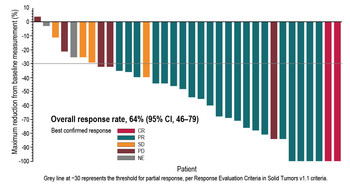Cancer patients struggle to understand what is involved in a clinical trial, even when they have participated in them. In a survey of 1090 adult cancer patients, more than half did not understand the concepts of clinical equipoise or randomization.
In the survey, 63% of patients thought that "my doctor would make sure that I got the better treatment in a clinical trial," and 55% said that "my doctor would know which treatment in a clinical trial was better."
The concept of randomization was also not understood. The survey involved 1090 patients who were attending 14 cancer centers in Ireland. About a third (30%) had already taken part in a clinical trial, but more than half of these patients did not understand that randomization means that the treatment would be allocated by chance. Among the cancer patients who had not participated in a clinical trial, the proportion was even higher ― 73% did not think that the choice of treatment was made on the basis of chance.
"This shows poor understanding of randomization, and we know this is a difficult concept for patients," commented lead author Catherine Kelly, MD, associate professor of medical oncology at the Mater Misericordiae University Hospital and University College in Dublin, Ireland.
"There is also the concept of clinical equipoise, that the reason you are doing the clinical trial is because there is uncertainty over which is the best option," she said in an interview. The results here were rather surprising, she said, because even patients who had been in a clinical trial still felt that the treating physician would choose the best treatment and, even more worrying, that the physician would make sure that they were getting the best treatment.
These responses show that patients "very much trust their cancer doctors, with the expectation that the doctor will know what is the best treatment and will ensure that they get it," Dr Kelly said.
The findings suggest that oncologists and their research teams need to explain more clearly these concepts and suggest a need for more training of communication skills, Dr Kelly suggested.
"Doctors have a responsibility to properly inform their patients in this regard, because they are the ones patients trust the most," Dr Kelly said.
"To provide informed consent when participating in a trial, patients need to understand these key concepts ― and doctors explaining them well is essential to alleviating any fears that might prevent patients from participating. For example, many didn't realize that clinical trials are not just an option for when standard treatment has failed," she observed.
Reacting to the findings, Dr Bettina Ryll, chair of the ESMO Patient Advocates Working Group, commented: "The question of whether patients understand clinical trial methodology is a very valid one, and what makes this study so interesting is that more than a quarter of the patients questioned had actually been on clinical trials before," she said.
"However, I was surprised at the median age of the cohort: 60 years. It would be interesting to compare the data collected here with younger patient groups, who access information in a very different way," Dr Ryll observed. "I would also expect to see differences across tumor groups: among breast cancer patients, for instance, who make up almost a third of the study cohort and for most of whom there is a well-established standard of care, clinical trials are likely to be of less interest than among lung cancer patients, for whom the standard treatment is less effective."
Dr Ryll further cautioned: "When we talk about understanding, it is important to consider that patients and physicians approach clinical trials from different perspectives. For example, the concept of randomization is one that many patients question from a moral standpoint. Equipoise, by contrast, may be a laudable moral concept, but it is difficult to uphold if the results of earlier trials are already known: finding out whether a treatment is, say, 51% better or only 49% may matter to an HTA [health technology assessment] assessor but not to a patient. This undermines the conclusion that patients simply do not understand equipoise."
European Society for Medical Oncology (ESMO) 2017 Congress. Abstract 1465P_PR, presented September 10, 2017.









